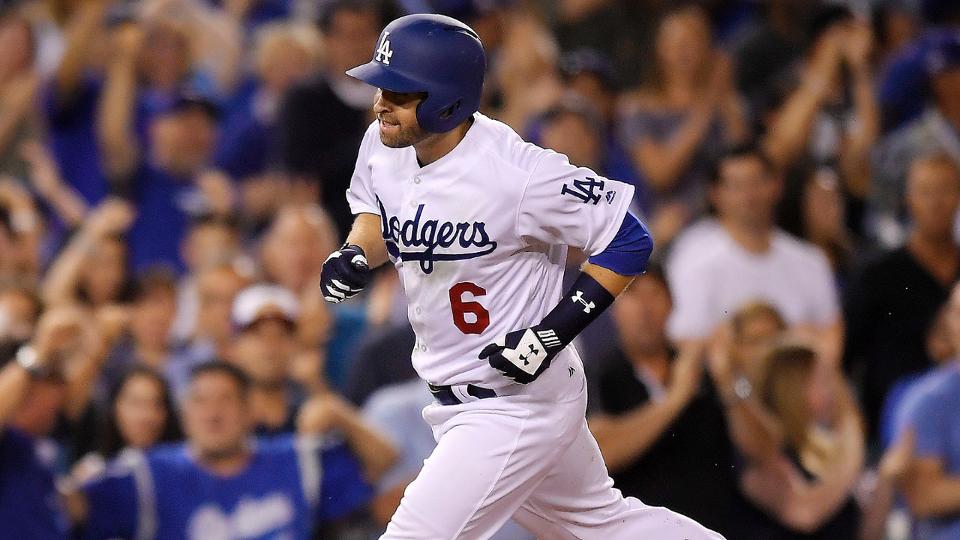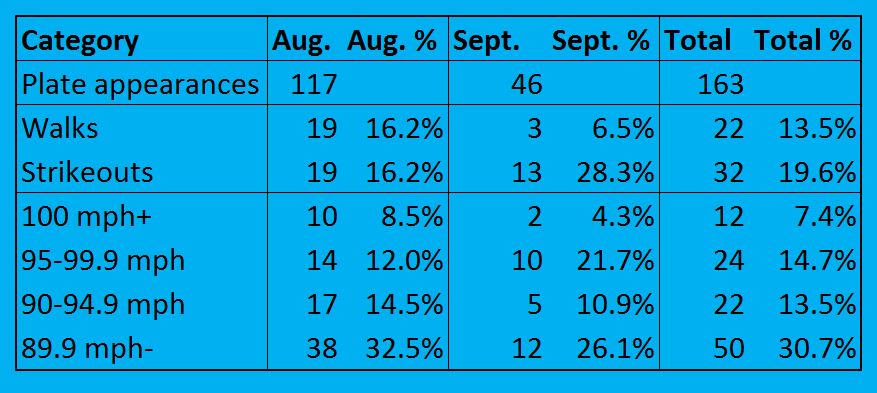Since his most recent home run, exactly four weeks ago on August 28, Dodger midseason acquisition Brian Dozier has been in a horrendous slump: 4 for 52 (one single, three doubles) with four walks, a hit-by-pitch and a stolen base. Translated, that becomes a .158 on-base percentage and a .135 slugging percentage.
Dozier has started the past five games and 16 of the 22 the Dodgers have played in that span. The team is showing him faith and/or just trying to get him going. That’s understandable, given not only the investment in trading for Dozier, but his .368 OBP/.448 slugging in his first 24 games with Los Angeles.
In addition, Dozier is probably the best fielding second baseman the Dodgers have, something that earns him a little extra rope offensively, even as he drops in the batting order.
Unfortunately, the latitude the Dodgers have shown simply hasn’t paid off. Dozier hit two home runs in his first two games with the Dodgers. He has hit two homers in 43 games since.
Against left-handed pitchers as a Dodger, Dozier’s OPS is .531. That’s nearly as poor as the typically platooned Joc Pederson (.508) and worse than Yasiel Puig (.650), particularly significant because whatever defensive tradeoff the Dodgers might make by moving a Chris Taylor or Kiké Hernandez to second base would be mitigated with the imposing Puig in right.
Dozier’s OPS against right-handed pitchers is .703, which is better in a vacuum but still the worst of any Dodger regular. A bone bruise on his right knee has only amplified the questions surrounding Dozier. From the Los Angeles Times on September 8:
“It’s been a struggle,” Dozier said. “I’ve had a knee issue since the beginning of the year.”
In April, as a member of the Minnesota Twins, Dozier sustained a bone bruise on his right knee. The Twins reported then that an MRI examination had ruled out structural damage. The soreness has remained, Dozier said, and the inability to swing freely has compromised his swing.
“If one side of your leg is not working, find a way to use your other side,” he said. “That’s just my mentality.”
Dozier said he believes he is healthy enough to play. He said neither the Twins nor the Dodgers had suggested a stint on the 10-day disabled list, and he said he would not have taken either team up on the suggestion.
“That’s not me,” he said. “I’ve never been on the DL. I hope to not ever be. My mentality has always been, you can still be productive if you’re not 100%. I’m still trying to find ways to be productive.”
Dodgers manager Dave Roberts said he is aware of the condition but has not been advised by the team’s medical staff that Dozier should not play.
With six games remaining in the regular season before a very possible playoff berth, the Dodgers have two decisions to make. Does Dozier remain in the starting lineup? And with rosters reverting back to 25 players in October, would Dozier make it to the postseason squad?
Slumps end, and sometimes the slumps themselves disguise a good player hitting into bad luck, so one way to answer the questions above might be to see if Dozier has deserved better for his efforts.
With Baseball Savant as a source, here is a chart showing Dozier’s performance at the plate with the Dodgers, divided into walks, strikeouts and balls in play broken out by exit velocity.
What do you make of the following?
- In the smaller sample size of September, Dozier’s walk rate has collapsed and his strikeout rate has soared.
- However, when he does make contact, Dozier is actually hitting the ball harder in September.
- In August, 30.3 percent of balls in play and 24.4 percent of his at-bats (excluding walks) have left Dozier’s bat at 95 mph or above.
- In September, 41.3% of balls in play and 28.6 percent of his at-bats (excluding walks) have left Dozier’s bat at 95 mph or above.
Right as you might have been ready to give up on Dozier, eight of the last nine balls to come off his bat have exit velocities of 95 mph or higher. Those efforts yielded two hits, both doubles, and six hard outs.
Dozier’s batting average on balls in play, which is .271 for his career and .256 with Minnesota this year before the trade, is down to .202 with Los Angeles. There is little doubt that Dozier is a better hitter than the .625 OPS he has delivered as a Dodger.
What’s not clear, however, is whether the 31-year-old will be a better player than the teammates he displaces in the lineup, either in the final week of the regular season or in any October games.
If you consider the following 12 position players locks for a potential postseason roster — Yasmani Grandal, Austin Barnes, Cody Bellinger, David Freese, Manny Machado, Max Muncy, Chris Taylor, Justin Turner, Kiké Hernández, Matt Kemp, Joc Pederson and Yasiel Puig — that might leave only one remaining spot.
Is Dozier, who only plays one position, more useful than non-catching catcher/infielder Kyle Farmer, pinch-runner Tim Locastro, veteran Chase Utley, relative contact hitter Alex Verdugo, or a 13th pitcher to play matchups with? Maybe. Maybe not.
You can understand the Dodgers taking as much time as they have to find out, but the time of reckoning is near.







Comments are closed.